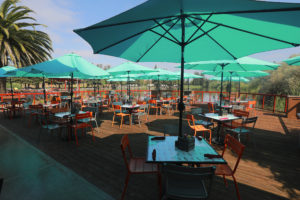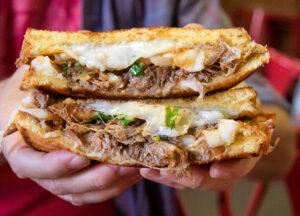For a brief and ill-advised moment, I considered describing the luscious and outrageously good Chardonnays being crafted over in the Alexander Valley as phat rather than fat, mainly because pretty hot and tasty summarily describes the better ones, but also because I’m hopelessly ignorant when it comes to the etymology and demographic appropriateness of modern slang. (If only my kids were a little older, they’d have warned me off such a disastrously dated bit of idiomatic faux pas, but as it stands, I’m just thankful for the folks over at UrbanDictionary for the heads-up…) The other issue, insofar as wine-geek vernacular is concerned, is that ‘fat’ can carry with it negative connotations more properly associated with the descriptor ‘flabby’, and which are not at all how I would characterize the big, rich, concentrated white wines of my AV neighbors.
Although I’ve written about Chardonnay in the parent posts to this thread (here and here), I’ve yet to get around to the most important bit, which is to say actually drinking the stuff; unless we’re batting in the DD spot, the PK staff has never been much for the whole swirl/taste/spit approach to wine-tasting, preferring instead to have our wine and drink it too, which is why the only logical conclusion to this thread is a visit to the wineries along Highway 128 . The catch: With so many good wineries, neither my liver, wallet, nor editorial guidelines allowed for a comprehensive tasting, so I capriciously chose just three (actually four, but we’ll get to that in a moment) of my favorite winemakers, each of of whom makes a 100% Chardonnay wine, from estate vineyards in the Alexander Valley AVA, and at roughly comparable cost: Stuhlmuller, Robert Young Estate, and Stonestreet.
Most of these are ‘luxury’ wines, with price and quality to match, and not the sort that I normally drink or write about (I’ve always been skeptical of the challenge, much less the practical application, in finding great wines at high prices). But I broke my usual rule for two reasons: I wanted to taste the purest, most expressive examples of whatever it is that constitutes the AV terroir; and I wanted ammunition for my assertion that the finest AV Chards can stand toe to toe with any of the big-name New World Chards, including the media darlings from folks like Turley, Kongsgaard, Aubain and Kistler that often sell for several times the price of their AV equivalents.
- Robert Young Estate Winery: 2008 Chardonnays, “Alexander Valley” ($40), “Area 27” ($44), and “Barrel Select” ($49). For me, RYEW is the benchmark for AV wines generally, and Chardonnay in particular – after all, the Youngs have farmed grapes from AV soils for a half-century at this point, and the principal clones in the Valley (#17 and #26) are actually called “Robert Young clones”, no matter where they grow. And talk about stacking the odds: The Robert Young vineyards include some 150 acres of Chardonnay, of which only the best 7 or so – less than 5% of the total – make it into the estate bottling. Despite wine-making differences (e.g., 100% new French oak on the Barrel Select; early harvest and neutral barrels on the Area 27), all three wines showcase the hallmarks of great AV Chard with remarkable consistency, loads of bright tropical fruit laced with smoky vanilla, garnished with toasted coconut, almonds and hazelnuts, all delivered with a sinfully rich and creamy mouth-feel. Put the Barrel Select in a blind tasting against the baddest boys over in Napa or out by the Coast; my money says it will hold its own, and then some.
- Stuhlmuller Vineyards: 2008 Chardonnays, “Estate” ($24) and “Reserve” ($38). Winemaker Leo Hansen – a burly, blond Dane of few words, intense focus, and, I suspect, the heartthrob of cellar rats from Geyserville to Chalk Hill – is making terrific wines from grapes grown in the side of the Valley opposite Robert Young. Creamy, toasty, and full-bodied, Leo’s Chards are an adult-beverage moral equivalent of Meyer lemon creme brulee, voluptuous and balanced at the same time. That the vines themselves are predominantly Robert Young Clone 17 provides another great example of AV terroir: To paraphrase Leo, it’s the right vine in the right place, and it shows in the glass. I particularly like the “Estate” bottling at 2/3 the price of the “Reserve” designation: It shows off a bit of everything its bigger sister has going on, but not quite as concentrated and in-your-face, and provides a terrific and much more affordable example of what these wines are all about. Highly recommended. (Note: When I was at the winery, they had the 2007 “Reserve” designation on sale for $30, an absolute steal for the quality and the vintage.)
- Stonestreet Winery: 2008 Chardonnays, “Alexander Mountain Estate” ($29, $26 at BevMo), “Upper Barn” ($55), “Broken Road” ($55). Stonestreet is an interesting story, the pet project of Jess Jackson and supported by seemingly unlimited resources. Most of the grapes are grown on the remote slopes and ridge tops in the Geysers area, high above the valley floor, and showcase the unique sites from which they come; they are by far the most distinctly different of the wines I tasted. Interestingly – and I suppose this makes sense – the oldest vines at the highest elevation, the “Upper Barn” vineyard, produce the least typical example of the “Alexander Valley” style, an admirable demonstration of a winemaker showcasing a particular patch of dirt with distinct micro-climate and soil; it is also the most “Burgundian” of all the wines I tasted, if that is your cup of tea. The “Estate” bottling, at about half the price of the vineyard-designates, was actually one of my favorites of the bunch, and once again flaunts the trademark balance of lushness, acidity, oak and fruit that seem to mark all of the wines I sampled.
- Chateau St. Jean: 2008 Chardonnay, “Robert Young Vineyard” ($22 club price, less another 5% by the half-case, at Safeway). With apologies, I didn’t make it to Chateau St. Jean, but I wanted to include this wine because it represents a vastly more affordable version of Robert Young. Different winery, different winemaker, and different vineyard blocks, but you can quite easily taste the essential Robert Young flavor profile (Robert Young supplies the grapes, from the same clones amongst their Estate vineyards). Taste this wine next to its much more expensive cousins, and I think you’ll be surprised how many common threads they share, another great example of the stylistic consistency produced by the vines. $20 isn’t a table wine, at least not in our house, but this is really solid stuff, and a great value for what it is (as are all of the Chateau St. Jean AV vineyard-designate Chardonnays, in fact).
If you like your whites hard, steely, and angular, these wines are not for you; if you’re all about cool-climate, crisp, citrus-fruit flavors, these wines are not for you; but if you love rich, creamy, concentrated Chardonnay – all baked pears and lemon custard, buttered toast and spiced nuts – then give these gems a try.









